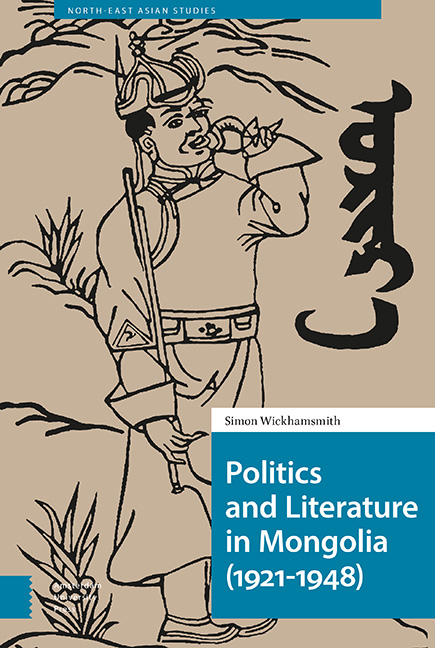Book contents
- Frontmatter
- Dedication
- Contents
- Transliteration and Mongolian Names
- Introduction
- 1 Prefiguring 1921
- 2 Staging a Revolution
- 3 Landscape Re-Envisioned
- 4 Leftward Together
- 5 Society in Flux
- 6 Negotiating Faith
- 7 Life and its Value
- 8 The Great Opportunistic Repression
- 9 A Closer Union
- Appendix: Brief Biographies of Writers
- Index
Transliteration and Mongolian Names
Published online by Cambridge University Press: 21 November 2020
- Frontmatter
- Dedication
- Contents
- Transliteration and Mongolian Names
- Introduction
- 1 Prefiguring 1921
- 2 Staging a Revolution
- 3 Landscape Re-Envisioned
- 4 Leftward Together
- 5 Society in Flux
- 6 Negotiating Faith
- 7 Life and its Value
- 8 The Great Opportunistic Repression
- 9 A Closer Union
- Appendix: Brief Biographies of Writers
- Index
Summary
The traditional vertical script (Mongol bichig) was gradually replaced by a modified version of Cyrillic between 1941 and 1950. This means that the majority of the texts mentioned in this book were originally printed in the vertical script. However, most of the texts available to readers and scholars inside and outside Mongolia – whether published before or after the Democratic Revolution of 1990 – have been reprinted in Cyrillic transliteration. For those who read Mongolian, transliterating the vertical script into Cyrillic affects the pronunciation and syllabification of the text, and therefore the rhythms, rhymes and essential sound that characterize the original are likewise compromised.
That said, my intention in translating texts for this book has been to convey the meaning rather than the music of the language, and those who read either or both the vertical script and Cyrillic will be able to read the texts for themselves.
To render the reading of Mongolian as easy as possible, I have chosen to use the Tibetan and Himalayan Library transliteration systems for both Cyrillic and the vertical script, although I use ‘v’ to transcribe the Cyrillic ‘в’. For Tibetan, I use the system laid out by Turrell Wylie. For Russian, I use the ALA-LC romanization system, and I use the traditional characters for Chinese.
As far as the transliterations of titles and personal names are concerned, I have chosen always to use the Cyrillic versions of personal names (i.e. Buyannemeh rather than Buyannemekü) for the sake of consistency. For the names of works, however, I have used the transliteration appropriate for the cited text, so that if I cite a text printed in vertical script, it is cited and referenced using transliteration of the vertical script, while a Cyrillic text is transliterated according to the Cyrillic script.
Mongolian names are given using the patronymic (occasionally matronymic) initial, followed by the given name. Thus the writer and scholar Damdinsüren, whose father was called Tsend, is Ts. Damdinsüren. There is but one exception to this rule. Chimid Dungaryn (D. Chimid) appears to have made a decision to use the more “Westernized” version of his name in his written work, with his given name placed first, and so I refer to him as Chimid Dungaryn or, where contextually clear, as Chimid.
- Type
- Chapter
- Information
- Politics and Literature in Mongolia (1921–1948) , pp. 9 - 10Publisher: Amsterdam University PressPrint publication year: 2020



